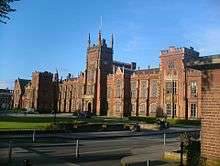Queen's University of Ireland
The Queen's University of Ireland was established formally by Royal Charter on 3 September 1850, as the degree-awarding university of the Queen's Colleges of Belfast, Cork, and Galway that were established in 1845 "to afford a university education to members of all religious denominations" in Ireland.
 | |
| Latin: Universitas Reginae Hiberniae | |
| Type | Public |
|---|---|
| Active | 1850–1882 |
| Location | , Ireland |
The university system itself was replaced by the Royal University of Ireland in 1880, which in turn was replaced by Queen's University Belfast, with the Cork and Galway colleges forming the National University of Ireland, along with University College Dublin.
The three Queen's colleges are currently known as:

Establishment
The Queen's Colleges (Ireland) Act 1845 (An Act to enable Her Majesty to endow new Colleges for the Advancement of Learning in Ireland) established the colleges with the intention that they would provide for Roman Catholic requests for university education, since Catholics did not generally attend Trinity College Dublin at that time (though there were no legal restrictions preventing them from doing so).
Nevertheless, at the prompting of Protestant interests, the Queen's Colleges were not permitted to give instruction in theology. Thus, the Queen's Colleges became derided as the "godless colleges" — Pope Pius IX even ventured as far as declaring them to be "detrimental to religion" in an official condemnation. This non-acceptance was articulated in the creation of a rival to the Queen's Colleges — the Catholic University of Ireland in Dublin.

In 1845 the Mayor of Limerick applied to have a Queen's College[1] located in the city; however Cork, Galway and Belfast were chosen.
The colleges were incorporated on 30 December 1845; and on 30 October 1849 they opened for students.[2] A Board of Queen's Colleges was created to draw up regulations for the colleges, consisting of the President and Vice-President of each college.
Academic degrees were conferred by the chancellor and senate of the university with a status similar to those of other universities of the former United Kingdom of Great Britain and Ireland.[2]
In 1866 the university considered examining and conferring degrees on students other than those of the Queen's colleges, such as the Catholic Carlow College[3] the St. Patricks College Carlow Report[4] was conducted and the college was deemed to meet the suitable, however it was never enacted.[5]
The Queen's College at Belfast became predominantly Protestant, unlike the colleges at Cork and Galway.
A number of significant figures in Irish public life participated in the governing senate of the university such as Sir Dominic Corrigan (Vice-Chancellor). Naturalist Robert Ball became secretary of Queen's University of Ireland in 1851. Thomas Spring Rice, 1st Baron Monteagle of Brandon served on the seante of the university.
Dissolution
The Queen's University was superseded by a new, inclusive, degree-awarding institution, the Royal University of Ireland in 1880.[2] The Queen's University was formally dissolved on 3 February 1882.[2] Immediately on incorporation, the Royal University broke with the “godless" convention, by setting examinations for, and awarding degrees to students of colleges with a religious heritage, notably Magee Presbyterian College, and the Catholic University of Ireland (that included St. Patrick's College, Maynooth and University College Dublin.)[6][7]
The Belfast college was separated from the other two in 1908, and became the Queen's University Belfast (QUB).[8] Queen's College, Cork is now known as University College Cork (UCC), while Queen's College Galway is now known as NUI Galway.[2] Since 1908 the latter two have been part of the federal National University of Ireland system.
References
- "The Early Years", Dr Edward M. Walsh, President Emeritus Archived 16 September 2005 at the Wayback Machine
- UCC, 2006. "UCC History" Retrieved 1 September 2006.
- Kennedy, David (1946), Towards a university : an account of some institutions for higher education in Ireland and elsewhere, and of the attitude of Irish Catholics to them, with particular reference to Queen's College and Queen's University, Belfast / by David Kennedy, Catholic Dean of Residences, Queen's University
- St. Patricks College Carlow Report, 1866 Introduction: Printed by T. Price, 55 Dublin St.
- Paul Cardinal Cullen and the shaping of modern Irish Catholicism By Desmond Bowen
- History of Magee College at UU Library website Archived 26 June 2017 at the Wayback Machine. Retrieved on 28 August 2006.
- O'Donnell, Patrick, 1912. "Catholic University of Ireland". The Catholic Encyclopedia, Volume XV, from 1993 online edition. Retrieved on 1 September 2006.
- QUB, 2006. "History of Queen's". Retrieved on 1 September 2006.
